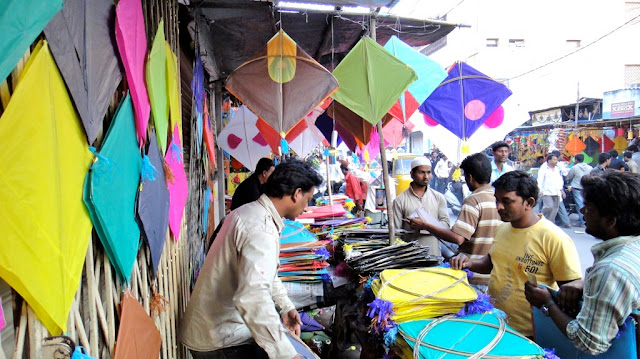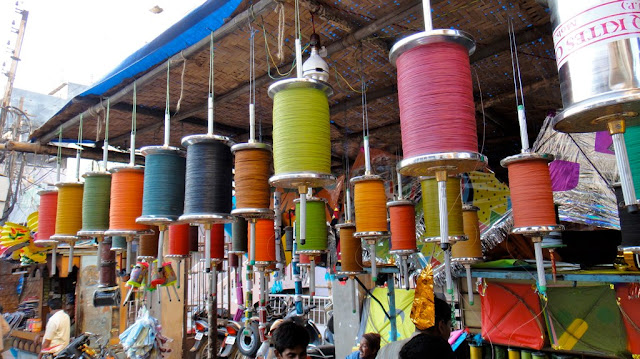 |
| A bat that died due to entanglement in kite string. Image credit: Mahesh Yadav/JY Brothers |
As a child, a sky full of colorful kites appeared like a fascinating painting, a thing of joy to me. Little did I know then that, years later, the same sight would cause me much pain and remind me of its association with the death of innocents. Every year, as India celebrates with kites during its various festivals like Sankranti, Holi, and Independence Day, thousands of birds meet an untimely death in the demonic strings of the kites that rip through their wings and cut through their bones or strangle their delicate necks. Not only that, people too are not spared, with several horrifying cases of children and adults meeting gruesome and unexpected deaths due to kite strings slitting their throats. All this happens just to give a few moments of joy to those who use this ancient Chinese-origin tradition adopted by India to boost their celebratory mood.
The Kite-Flying Tragedy
 |
| A crowded Delhi kite market. Image credit: Rajesh_India via Flickr.com |
Here are some facts and figures to show just how shocking the results of kite flying can be. Uttarayan, the kite-flying festival held in Gujarat in January 2023, claimed the lives of six, including three children, and injured 176 others from cuts and falls. A two-year-old girl and a seven-year-old boy riding on scooters with their respective parents, and a three-year-old girl walking home with her mother suffered fatal injuries when kite strings slit their throats, killing them. Imagine the suffering of the children and their parents that was caused just because some people somewhere were flying kites for momentary glee. More recently, in July 2023, a seven-year-old girl died due to the same cause as she was riding on a bike with her family in Delhi's Paschim Vihar. While kite-string-related injuries are one form of the danger posed by kite-flying, many, including children, also die due to falls or electrocution while flying kites as they stop paying attention to their own safety in their obsession with chasing kites.
So, if the act of kite-flying can cause so much harm on the ground, imagine the disaster happening in the air - to the birds for whom the web of strings in the sky serves as a massive, vicious death trap.
 |
| A bat caught in kite string that died due to entanglement. Image credit: Mahesh Yadav/JY Brothers |
Kite flying during Sankranti celebrations in January 2023 in Mumbai resulted in injuring over 900 birds, a figure provided by activists who rescued them, while the actual number is possibly much higher. The 2018 kite flying celebrations in Gujarat demanded the rescue of at least 4,000 birds and killed at least 214. Such figures come up only in places where rescue camps are set up to save the birds, but one can imagine the scale of deaths occurring in places where there is no rescue - birds dying in thousands. While pigeons, crows, sparrows, parakeets, kites (the bird), etc., are common victims in such cases; rare, threatened, or migratory birds like vultures, sarus cranes, peregrine falcons, eagles, etc., have also succumbed to kite-related injuries. Other flying animals like bats are also not safe from this threat as the above picture demonstrates.
What Kills?
 |
| Kite strings on sale at a market in Delhi. Image credit: Rajesh_India via Flickr.com |
So, the question is, how does a seemingly happy-looking kite prove to be so deadly? The answer lies in its string. For birds, be it made from cotton or Chinese manjha, any kind of kite string can kill. However, both for humans, birds, and other animals like bats, etc., the Chinese manjha (referring to kite strings made of synthetic materials like nylon or plastic, or metals, etc., and usually coated with ground glass) are truly deadly.
The Chinese manjha is usually used by kite flyers who compete to cut each others' kites in the air - the sharper the string, the easier it is to cut your competitor's kite. This game that is meant for fun, however, takes a lethal turn when flying birds get entangled in the strings or when kites carried by winds land on trees, trapping birds in them. As birds struggle to free themselves, they get further entangled. The strings cut through their wings or neck, often leading to fatal injuries and death if not rescued and treated in time. Sometimes, kites with Chinese manjha, blown away by strong winds, achieve such speeds that they cut through the throat of people in the open, killing them even before they can reach the hospital. Such is the demonic nature of the Chinese manjha.
 |
| People flying kites on terrace. Image credit: Premsagar via Flickr.com |
In addition to string-related deaths, kite flyers themselves also sometimes suffer debilitating injuries or even die when chasing kites. With their eyes on the kite, especially when flying them from open high terraces or other high ground, they become highly susceptible to accidental falls.
Possibly Chinese-Origin But Definitely Not Chinese Manjha
Interestingly, the Chinese manjha is actually not from China but is domestically produced in places in India where kite flying is a popular activity. However, the practice of kite flying is believed to be of Chinese origin. The earliest accounts of the activity date to 206 BC in ancient Chinese literature that mentions the use of kites for exhibiting military might and calculating distances in warfare. Over the years, China's kites traveled across the world and, of course, into neighboring India, where they gradually grew in popularity, especially during the Mughal times when the royals often celebrated with the kites. Today, kite flying is usually practiced during festivals like Makar Sankranti, Baisakhi, and Independence Day, and Gujarat even hosts a kite festival and a museum dedicated to kites.
The Law And The Experts: What They Say?
The National Green Tribunal in 2017 issued a countrywide ban on the sale and use of manjha that is "made of nylon or any synthetic material and/or is coated with synthetic substance and is non-biodegradable." The move was welcomed by environmentalists and animal activists, who then lobbied for a complete ban on all kinds of manjha, given that any kind of manjha is dangerous to birds. Despite the ban, however, as per news reports, Chinese manjha continues to be sold in markets even today. A section of environmentalists and activists feel that only a complete ban on kite flying can ensure the safety of birds and people from kite-related injuries and deaths as even cotton threads are harmful to birds. However, such a ban is difficult to achieve. For example, in response to a public interest litigation demanding a ban on kite-flying, the Delhi High Court mentioned that such a complete ban was not possible given the cultural and religious significance associated with kite-flying (although the practice is believed to be of Chinese origin and non-indigenous).
At the end of the day, activists, conservationists, and the media can only help create awareness, but the choice is with the people - the general public - the adults and children who love flying kites. Would they be ready to give up their favorite sports to save the lives of people and birds that might possibly meet a tragic death if their innocent kites turned criminal? Only time will tell, but till then, education and awareness campaigns must go on.
Written by: Dr. Oishimaya Sen Nag

No comments:
Post a Comment